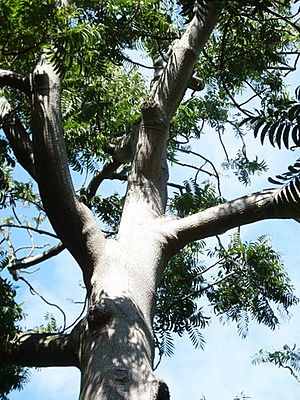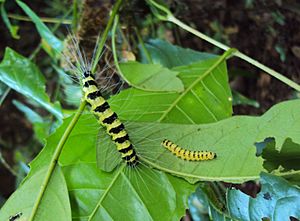Ailanthus triphysa facts for kids
Quick facts for kids Ailanthus triphysa |
|
|---|---|
 |
|
| Scientific classification | |
| Genus: |
Ailanthus
|
| Species: |
triphysa
|
| Synonyms | |
|
|
Ailanthus triphysa, also known as Ailanthus malabarica, is a medium to tall evergreen tree. It grows in rainforests across parts of Asia and Australia. People use its wood for things like matchsticks and plywood. In India, this tree is called halmaddi. Its special sticky sap, also called halmaddi, is used to make incense. Sadly, some ways of collecting this sap hurt the trees. Because of this, the Indian forestry department stopped people from collecting it in the 1990s.
Contents
Where Does It Grow?
This tree can be found in many places around the world.
- In Asia, it grows in India (including the Andaman Islands), Sri Lanka, Myanmar, South-Central and Southeast China, Thailand, Laos, Malaysia (including Peninsular Malaysia, Sarawak and Sabah), Cambodia, Vietnam, Philippines, and parts of Indonesia (like Jawa, Kalimantan, Sulawesi and Maluku).
- In Australia, Ailanthus triphysa grows in two main areas. One is in Western Australia, near the Prince Regent River and on Coronation Island. The other area stretches from Cape York in Queensland down to the Susan Island Nature Reserve in Clarence River (New South Wales).
What Does It Look Like?
Ailanthus triphysa is a medium to tall evergreen tree. It can grow up to 30 meters (about 98 feet) tall and its trunk can be 1.2 meters (about 4 feet) wide. The trunk is usually straight and round, not wide at the bottom. Its bark is grey and feels a bit rough, like sandpaper.
Its leaves are made up of many smaller leaflets, like a feather. These leaflets are curved and shaped like a sickle, coming to a sharp point. They are often uneven at their base. You can see the veins clearly, especially on the underside of the leaf.
The flowers are a creamy green color. In Australia, they usually bloom from November to January. The fruit is a special kind of winged seed called a samara. These often grow in groups of three.
Tree Parts
- Bark: The bark on the stem is greyish. When you cut the bark, the inside looks yellow with red spots.
- Leaves: The small branches that hold the leaves are about 1 centimeter (0.4 inches) thick. The individual leaflets are curved and about 5-12 cm (2-4.7 inches) long and 0.9-2 cm (0.35-0.8 inches) wide. They are very uneven at their base. If you look closely with a magnifying glass, you can see many tiny oil dots.
- Flowers: The flowers are greenish-yellow. They grow in clusters about 10–20 cm (4-8 inches) long. In India, the tree flowers from December to May.
- Fruit: The fruits are green to greenish-brown and feel like paper. Each winged seed (samara) is about 5-6 cm (2-2.4 inches) long and 1–2 cm (0.4-0.8 inches) wide.
Where It Lives
This tree likes to grow in certain types of forests.
- On Yamdena island in eastern Indonesia, it lives in dry forests. Here, it grows as a smaller tree, usually under 4 meters (13 feet) tall, under taller trees like Diospyros and other Fabaceae trees.
- On Coronation Island, off the coast of Western Australia, it grows in thick, dense patches of rainforest. Because there are not many of these trees in Western Australia, and they grow in small, separate groups, they are important to protect.
What Is It Used For?
The wood of Ailanthus triphysa is yellowish and can break easily. However, it makes excellent charcoal. It is also used to make matchsticks and plywood.
When the bark is cut, a sticky sap comes out. This sap becomes hard and brittle when it dries. This dried sap is used for medicine. It is especially popular for its nice smell, so people burn it as incense. In India, this incense sap is called halmaddi.
Sadly, people used to collect the sap in ways that harmed the trees, causing them to die. By the 1990s, the Forest Department in India stopped people from collecting the sap. This made halmaddi more expensive, so it is not used as much in incense making anymore.
In Cambodia, people also use the sap as incense. The bark is used in traditional medicine to help with stomach problems and swelling.
The wood of the tree contains natural chemicals called alkaloids and quassinoids. These chemicals have been used in traditional medicine to help with upset stomachs, breathing problems, eye infections, and even snake bites.
Names of the Tree
Besides its scientific name, Ailanthus triphysa has other common names:
- In India, it is called halmaddi or but.
- In Khmer (Cambodia), it is called hoëm thôm, which means "severe swelling".
- In Vietnam, it is called thanh thât.
- In Australia, it is sometimes called white bean or ferntop ash.
Images for kids
See also
 In Spanish: Ailanthus triphysa para niños
In Spanish: Ailanthus triphysa para niños



